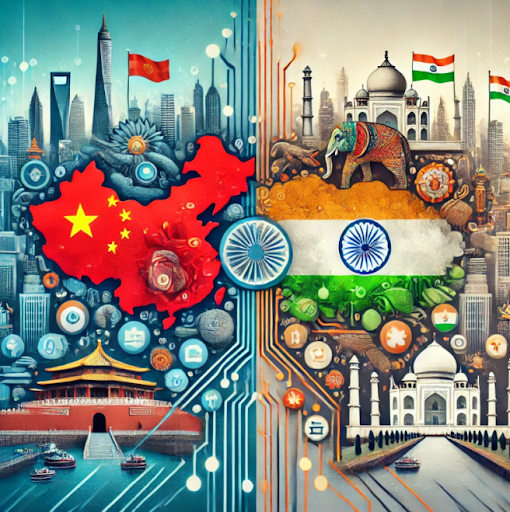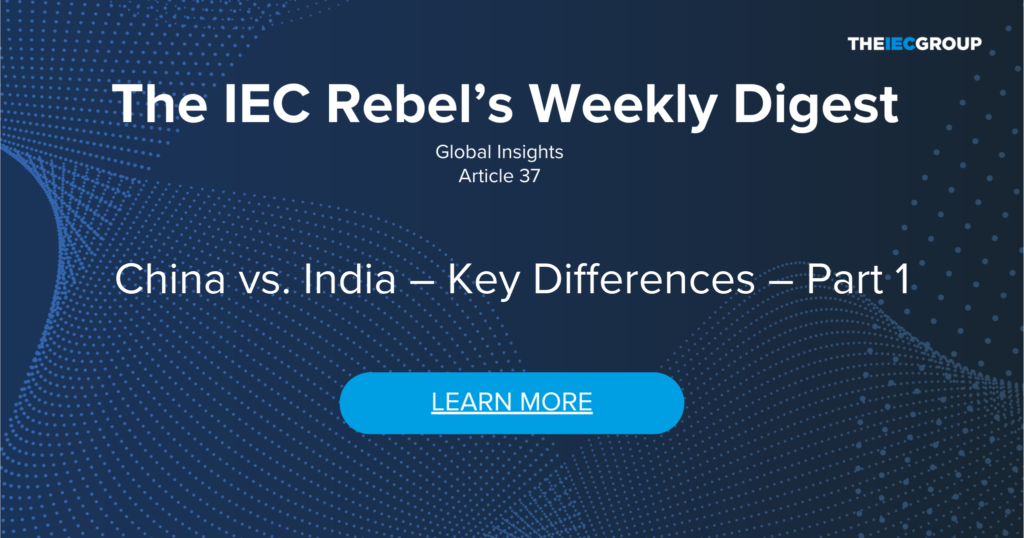China vs. India – Key Differences in the World’s Most Populous Nations – Executive Summary
 China and India, home to nearly 3 billion people, are two of the world’s largest and most dynamic markets. Their economic growth offers significant opportunities, but success requires understanding their distinct differences in economics, regulations, culture, and lifestyle.
China and India, home to nearly 3 billion people, are two of the world’s largest and most dynamic markets. Their economic growth offers significant opportunities, but success requires understanding their distinct differences in economics, regulations, culture, and lifestyle.
Economic and Business Landscape
China is a global leader in manufacturing and technology, while India excels in IT services and pharmaceuticals. China offers streamlined business processes within a controlled regulatory environment, often requiring local partnerships. India presents a more decentralized regulatory landscape with opportunities in its youthful consumer market, though challenges like bureaucracy remain.
Living and Cultural Differences
Expatriates in China enjoy high urban living standards but face strict government oversight. India offers a rich cultural experience with more open societal norms, though infrastructure varies. Success in both countries requires cultural sensitivity—relationship-building in China and regional adaptability in India.
Strategic Approach
Entering these markets demands tailored strategies. Partnerships are crucial in China, while in India, local alliances and localization are key. Understanding these differences is essential for thriving in
China and India, with nearly 3 billion people combined, represent two of the largest and most dynamic markets in the world. Their economic growth and global influence offer vast opportunities for businesses and investors. However, successfully navigating these markets requires a clear understanding of their distinct differences across various dimensions—economic environments, regulatory frameworks, cultural norms, and lifestyle factors.
Economic Landscape and Growth Opportunities
China, the world’s second-largest economy, is a global leader in manufacturing, technology, and infrastructure development. India, while the fifth-largest economy, is recognized for its strong IT services sector, growing pharmaceutical industry, and expanding consumer market. Both countries provide significant opportunities: China with its established manufacturing base and technological advancements, and India with its youthful population and demand for IT and consumer goods.
Establishing a Business: Challenges and Considerations
Setting up a business in China and India presents unique challenges. China offers a more streamlined process but operates within a tightly controlled regulatory environment. Success often requires partnerships with local firms to navigate restrictions. India’s regulatory landscape is more decentralized, with significant state-by-state variation. Despite improvements in business ease, challenges like bureaucracy and infrastructure persist.
Living and Working: Cultural and Lifestyle Differences
Living in China offers a high standard of urban living with strong infrastructure and safety, but with limitations on freedoms and government oversight. India offers a diverse cultural experience with more open societal norms, though living conditions and infrastructure quality can vary widely. Cultural understanding is crucial—relationship-building is key in China, while navigating regional diversity is essential in India.
Strategic Market Entry
Both markets require different strategies. In China, partnerships with local firms are often necessary to navigate the regulatory environment. In India, local alliances can help overcome logistical challenges and tap into regional markets. Localization and cultural sensitivity are critical in both countries.
Conclusion
China and India provide immense opportunities but demand careful strategic planning and a deep understanding of their distinct environments. This series of articles will explore these aspects in greater detail, offering insights on how to thrive in these rapidly evolving markets.
Part 1: An Overview
India and China are the two most populous countries in the world, with unique similarities and differences in terms of population, economy, and other indicators. Below is a comparison between the two:
- Population
- China: As of 2024, China’s population is estimated to be around 1.41 billion people.
- India: India’s population is also estimated to be around 1.42 billion people, making it slightly larger than China.
Global Population Percentage:
- China: Approximately 17.8% of the world’s population.
- India: Approximately 17.9% of the world’s population.
- Economy (GDP)
- China: China has the second-largest economy in the world, with a nominal GDP of approximately $18 trillion USD.
- India: India is the fifth-largest economy, with a nominal GDP of around $3.7 trillion USD.
Global GDP Percentage:
- China: Roughly 18% of the global GDP.
- India: Around 3.4% of the global GDP.
- GDP Per Capita
- China: Around $12,500 USD.
- India: Approximately $2,600 USD.
Comparison: China’s GDP per capita is significantly higher than India’s, reflecting higher levels of industrialization, infrastructure development, and urbanization.
- Economic Growth Rate
- China: China’s economy has been growing at around 5-6% in recent years, slowing down compared to its previous double-digit growth rates.
- India: India’s economy has been growing at a rate of about 6-7%, positioning it as one of the fastest-growing major economies.
- Urbanization
- China: Approximately 60% of China’s population lives in urban areas.
- India: Around 35% of India’s population lives in urban areas.
Comparison: China is more urbanized than India, with a larger portion of its population residing in cities.
- Demographics
- China: The median age in China is around 38 years. China is experiencing an aging population, with a declining birth rate.
- India: The median age in India is around 28 years. India has a younger population with a higher birth rate compared to China.
- Military Spending
- China: China has one of the largest military budgets in the world, spending around $230 billion USD annually.
- India: India’s military spending is approximately $76 billion USD.
Comparison: China’s military expenditure is significantly higher than India’s, reflecting its broader global strategic ambitions and larger defense capabilities.
- Education
- China: High literacy rate at around 96%.
- India: Literacy rate is around 77%.
Comparison: China’s education system is generally more developed, with a higher literacy rate and greater investment in tertiary education.
- Health
- China: Life expectancy is around 77 years. China has a more developed healthcare system.
- India: Life expectancy is about 70 years. India’s healthcare system is improving but still faces challenges in terms of access and quality.
- Technological Development
- China: Leading in areas like 5G, AI, and manufacturing. Home to tech giants like Huawei, Tencent, and Alibaba.
- India: Strong in software development and IT services, with companies like Infosys and TCS, but still developing in hardware and advanced tech sectors.
Summary of Similarities and Differences:
- Similarities:
- Both countries have over 1.4 billion people, representing significant portions of the global population.
- Both are major players in the global economy, with large and growing economies.
- Both are nuclear powers with significant military capabilities.
- Differences:
- Economic Scale: China’s economy is much larger in terms of GDP and GDP per capita.
- Urbanization: China is more urbanized than India.
- Demographics: India has a younger population, while China faces an aging demographic.
- Technological Leadership: China is more advanced in certain high-tech industries, while India leads in IT services.
These differences and similarities highlight the unique paths these two giants are taking in their development, each with distinct challenges and opportunities in the coming decades.
Go To’s: This is Part one of several articles about China and India to give you better inside for your decision process.
Introducing the IEC Knowledge Network Free Membership – Your Gateway to Seamless Access!
We are thrilled to present a new service that goes beyond the ordinary download experience. In addition to offering you the ability to download the things you love, we are delighted to introduce the IEC Knowledge Network Free Membership.
The Free Membership option grants you access to our library of articles and videos, without the need for tedious registrations for each piece of content.
The publication serves as a trusted resource to support executives in their pursuit of sustainable and successful global expansion. In addition the IEC Practitioners are available to discuss your specific challenge in more detail and to give you clear advise..
Take advantage of this valuable resource to accelerate your global expansion journey


